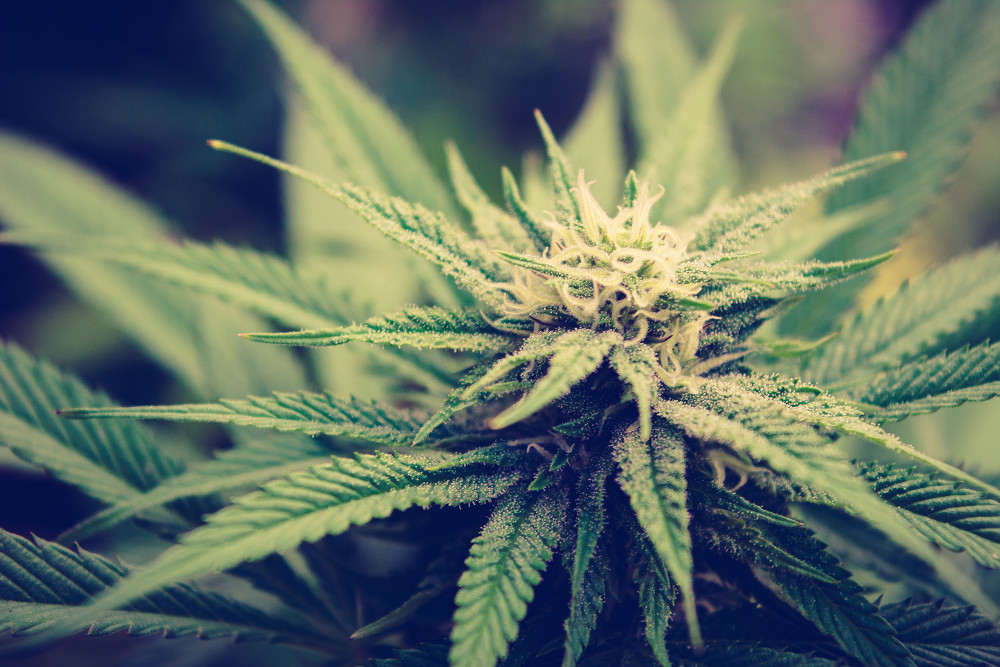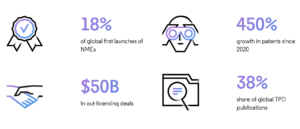
The great green rush
It's the most commonly cultivated, trafficked and abused illicit drug worldwide, and there's still a lot of social stigma attached to the recreational use of pot. But it's slowly dawning on regulators in countries from Canada to the US to South Africa that by ignoring the clear medical benefits of marijuana, they may have thrown the baby out with the bathwater. Countries across Europe are now also opening their minds, laws and wallets to cannabis.
When every other method fails to control a patient’s pain, a low-dose cannabinoid treatment can be a highly effective approach, says Dr. Marc Seibolt. He works at the Munich-based Algesiologikum MVZ GmbH, one of Germany’s largest pain therapy clinics. Since 2013, Seibolt has been prescribing medical cannabis as an additional therapy if various other treatment methods prove ineffective or are simply not providing sufficient relief. Cannabis-based drugs have huge potential for patients with chronic – especially neuropathic – pain, spasticity in multiple sclerosis, and loss of appetite, nausea and vomiting, the pain expert says. The German government now also recognises that potential, and legalised the medical use of the Cannabis sativa plant in March 2017.
Around 147 million people – or nearly 2.5% of the global population – consume cannabis regularly. The World Health Organisation (WHO) says that makes marijuana and the family of other products derived from the plant the most commonly cultivated, trafficked, and abused illicit drug worldwide.
But more and more, its bad reputation is improving. Cannabis no longer provides just a way for people to get high, but is increasingly recognised for its proven pharmaceutical benefits in fields like pain management. The newly enacted cannabis legislation has led to a much wider acceptance of cannabinoids as a drug in the population than was previously the case, says Prof. Dr. Sven Gottschling, Chief Physician at the Center for Palliative Medicine and Child Pain Therapy at Saarland University Hospital. He began working with cannabis products as a pediatric oncologist, where he treated children with cannabinoids who had massive appetite disorders and weight loss. Before long, it gained acceptance in cancer therapy as a good way to stimulate appetite and at the same time relieve nausea. In the past, I had to convince and persuade sceptical patients. But today, many patients approach us proactively with the desire for a cannabinoid therapy. In particular, the demand for flowers has certainly risen.
Health insurance companies hesitant about paying for it
Before the law was liberalised in Germany, patients who suffered from diseases like multiple sclerosis, chronic pain or cancer could only use cannabis if they had applied for a specific exemption at the country’s Federal Institute for Drugs and Medical Devices (BfArM). As regulations were extremely strict, that effectively meant only a few hundred patients with specific indications were granted permission to use the plant for medicinal purposes. But numbers are now rising steadily. Figures from market research institute IQvia reveal that there were around 3,500 prescriptions issued directly in March last year. By October, that number had more than doubled to around 7,300 prescriptions.
Overall, physicians in Germany like Seibolt and Gottschling are now able to treat significantly more patients with cannabinoids because the legalisation has made it possible for patients to apply via an application procedure without any indication restrictions. That said, only around 60% of all applications submitted are currently approved by health insurance companies. In addition to the bureaucracy, a lack of solid studies still leads to high rejection rates by health insurers when it comes to reimbursing patients for the drug. 70% of my patients respond to cannabinoid therapy, says Seibolt. I believe the intensive studies and research that are now being carried out will enable us to better identify the indications for which cannabinoids offer a real benefit.
A hundred active ingredients
Cannabinoids’ is a collective term for the substances present in the resin of the hemp plant. The female plant produces over 100 phytocannabinoids. From among them, the most intensively studied so far are the psychotropic tetrahydrocannabinol (THC) and the primarily anti-inflammatory compound cannabidiol (CBD). Both bind to receptors in the body’s endocannabinoid system (ECS – see opposite page).
Medicinal cannabis is usually given to patients in the form of buds from the hemp plant. Whether the patient then prepares it as tea, smokes it in a joint, nebulises it or cooks it in biscuits is up to him or her. The type of administration can have a considerable influence on the absorption of the active ingredient. There are also state-approved cannabis-based pharmaceuticals that have undergone approval procedures and clinical studies. These drugs have a standardised composition, and their effects and side effects are well known. The first approved medicine to target the endocannabinoid system was Marinol. That’s the brand name for a synthetic form of THC called dronabinol that was originally introduced in the early 1980s to treat symptoms caused by AIDS. Two other preparations have since been given the go-ahead: Nabiximol Spray, a high-alcohol solution that’s approved for therapy refractory spasticity in multiple sclerosis, and the synthetic cannabinoid Nabilone for the treatment of therapy refractory nausea under chemotherapy.
Since its legalisation for medical uses, German physicians have also been allowed to prescribe cannabis extracts and cannabis blossoms for their patients.
The domino effect in Europe
In the last few years, there has been a major shift in Europe’s understanding of cannabis. Countries across the continent are cautiously opening up to the idea of more normalised use in society. While the legal status of cannabis varies from country to country in the EU, many governments now take a more progressive approach. The dominoes began to fall in 2003 with the legalisation of medical cannabis in the Netherlands, and the effect soon reached other nations – including Germany, which has some of the strictest anti-narcotics laws in Europe. Today, the list of countries in Europe that have legalised or are considering the legalisation of cannabis for medical purposes is long. It includes Germany, Denmark, Macedonia, Malta, Italy, Belgium, the Netherlands, Portugal, the Czech Republic, Luxembourg, Croatia, Estonia, Finland, Poland, Greece, Norway, Ireland, the UK and Lithuania. The European Industrial Hemp Association (EIHA), nova-Institute and HempConsult estimate that the European market for CBD as a pharmaceutical product is already worth €2bn. According to the 3rd edition of The European Cannabis Report that’s published by market intelligence firm Prohibition Partners, Europe’s medical cannabis market could be worth €55bn once all member states have implemented legislation and market infrastructure.
With a market of over 742 million people, and healthcare spending that totals €2.3tn, Europe is potentially the largest medical cannabis market in the world, which is making it attractive for global cannabis producers. Canadian manufacturers in particular have been signing export deals with European governments, and also buying local companies and opening production facilities in the region. Prohibition Partners says Canadian firms account for the majority of operating licenses in Europe along with around 70% of all European cannabis imports. A major player in medical cannabis research, cultivation, processing, distribution and export of cannabis-based products is Canadian company Tilray Inc. In 2016, we were the first company that legally exported medical cannabis products from North America to Europe, says Marla Luther, Director of Business Development Europe at Tilray Inc.
The situation right now in many European countries is similar to that in Canada back in 2014, when the Canadian government decided that patients should only purchase cannabis products from licensed providers.
From start-up to global company
At that time there were a lot of hemp-growers with huge knowledge about the plant, but they barely had enough capital to produce pharmaceutical-grade cannabis, says Luther, who has been working for Tilray since it was founded. So the Canadian Department of Health approached today’s Tilray executive Brendan Kennedy to invest in one of the companies that applied for a license. Kennedy owns private equity firm Privateer Holdings, which has been investing in the legal cannabis industry since 2011. After a lot of discussion and research, the executives didn’t find a suitable company that knew the cultivation as well as they did themselves – so they decided to found Tilray, explains Luther.
Five years on, the medicinal cannabis company sells its products to patients, researchers and pharmacies all over the world, and was the first such company to conduct an IPO in the US in 2017. In the process it raised US$153m in capital. Then in early October, Tilray announced the closing of an additional US$435m in net financing, on top of the cash it received from its IPO. That money can now be used to explore market possibilities in Europe.
Portugal – the right place to be
Last year Tilray announced the investment of €20m through its affiliate Tilray Portugal Unipessoal Lda to build an EU Campus located in the Biocant Research Park in the Portuguese city of Cantanhede. It will in future cultivate, process, package, and distribute GMP-grade medical cannabis products to qualified patients, pharmacies, and researchers throughout the European common market. For two years, we have been searching intensively for a suitable location in Europe from which to serve the rapidly growing European market for high-quality, rigorously tested medical cannabis products, says Tilray CEO Brendan Kennedy, and Portugal has an ideal climate for growing cannabis, a large number of qualified professionals and a large scientific community.
The EU campus will be home to both indoor and outdoor facilities, along with greenhouses. In addition, facilities for the processing, packaging and distribution of medical cannabis products are to be built. The first live cannabis samples were exported from Canada to Portugal last year. As we are working with natural plants you still need some time for the growing process. Right now we are finishing the last construction and regulatory requirements, and will be exporting from the facility in 2019, says Luther. With its two new greenhouses covering 30,0000 m2, Tilray’s cannabis production should rise to 62 tonnes per year. The first legal medicinal product grown in the EU will then be available for patients next year.
It remains a plant
We know a lot about cultivation, harvesting, and the different batches of the cannabis plant, but it still remains a plant and you can’t say that every batch has exactly identical levels of active ingredients, explains Luther. According to her, active ingredient content in plants can vary from harvest to harvest by 15% or more. Tilray has developed cannabis full-spectrum extracts which, in addition to the main active ingredients THC and CBD, contain the other compounds found in cannabis flowers like terpenes. Both extracts are refined in grape seed oil, and remain natural products that smell like cannabis and have a yellow-green colour.
Clinical research important
It’s an unprecedented situation in the therapy of patients, exclaims Luther. All over the world, public health systems are providing access to products for which there are hardly any approved products. To promote clinical research, Tilray founded a German subsidiary in Berlin last year. Germany is of course particularly interesting due to the rich research landscape and excellent university hospitals. And the infrastructure in the healthcare market is so advanced there that we not only see opportunities to sell our products commercially, but above all to drive our research and development forward, says Luther. As public interest in cannabis-derived medicines continues to grow, we need objective, valid data about the potential risks and benefits of medical cannabis gathered through clinical trials and the scientific methods. Tilray is currently developing specific cannabinoid and terpene profiles for study drugs based on preclinical and clinical data, generating relevant pharmacokinetic parameters of study drugs and establishing and maintaining a pharmacovigilance database.
Tilray isn’t the only company to sense a big opportunity with medical cannabis in the EU. Aiming to pursue the cultivation and worldwide distribution of organic, EU GMP-certified medical cannabis, in September Aphria Inc. announced a strategic partnership with Danish Schroll Medical, a subsidiary of prominent European flower producer Schroll Flowers.
Who’s in the race?
The company has already received its license for the cultivation of medical cannabis from the Danish Medicines Agency, and currently owns property where production has started in a retrofit greenhouse. Its first products are expected by early 2019. To strengthen its end-to-end operations and infrastructure in Germany, Aphria also announced the €24.5m acquisition of CC Pharma GmbH in November.
Earlier this year, through its whollyowned subsidiary Aphria Deutschland, the firm acquired a 25.1% interest in Berlin-based Schöneberg Hospital. That move was made to provide access to support education for both doctors and patients on the benefits of medical cannabinoids. It was also the first step in Aphria Deutschland’s plans to build and operate pain treatment centres throughout the country.
Tilray and Aphria are just two companies in what’s become a crowded field. However, doctors like German palliative physician Gottschling say we should be careful not be too precipitous. An almost unmanageable number of cannabis suppliers are now entering the market. Should this competition serve to encourage different companies to support urgently needed research projects, among other things, I see this as a positive development, Gottschling says. However, you now notice a certain gold-rush atmosphere. Many companies simply want to grab a piece of the tempting pie, but that won’t actually change or improve care for patients. We doctors are also caught in a maze of different providers, so due to the sometimes rather aggressive marketing strategies, we need to be careful to keep our bearings.


 IQVIA
IQVIA White House
White House Clarivate
Clarivate